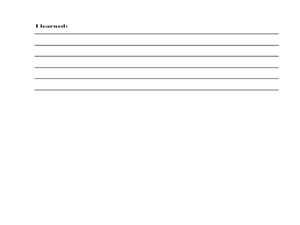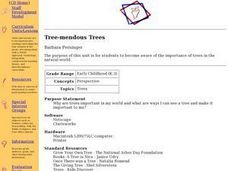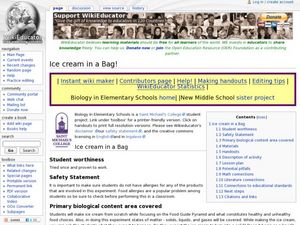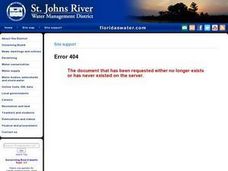Curated OER
Let the Weather Help You Dress
Students observe weather daily for at least a month and graph the weather for one month. Then they use weather vocabulary such as sunny, windy, rainy, stormy, cold, snowy, foggy, and hot, and share their predictions about weather. ...
Curated OER
Mendel's Laws of Heredity
In this heredity worksheet, students will review the work Mendel did on predicting how traits were passed down from generation to generation. Then students will review monohybrid and dihybrid crosses and Punnett squares. This worksheet...
Curated OER
Force and Motion
Students experiment with force and motion. In this force and motion instructional activity, students test gravity using a variety of objects. Students rotate through a series of stations which use force, motion, friction, and inclines....
Curated OER
Density and Mass
Learners experiment to find which liquids are more dense. In this density and mass activity, students predict and then test objects to observe and measure their density. learners observe which items sink and float. Students complete...
Curated OER
Creeping
Young scholars observe, measure, and graph a model of slow down slope movement representing soil creep. This task assesses students' abilities to collect, record, and organize data, set up graph axes, plot data points, draw line graphs,...
Curated OER
Nature: Planting Terrariums
Students observe and experiment using a terrarium. In this scientific lesson plan, students build a nature terrarium. Students then observe their terrarium over a period of time to discover what makes the plants grow. A science...
Curated OER
Tree-mendous Trees
Students become aware of the importance of trees in the natural world. Students are shown 2 filmstrips - Special Things About Trees and Tree Magic. Students plants seeds. They, students predict the growing chart of tree growth. Students...
Curated OER
Peat Pots
Students place a peat pot in water to observe and calculate the rate of capillarity in a model of a soil. This task assesses students' abilities to make simple observations, collect, record, and represent data, use a data table to...
Curated OER
Probing Under the Surface
Eighth graders use a measuring stick to determine the shape of the inside of the bottom of a box, then apply their knowledge to an additional situation. This task assesses students' abilities to make simple observations, collect and...
Curated OER
River Planning
Students use a model to conduct an experiment involving dam construction. Based on their observations, they draw conclusions about social, economic, and and environmental issues and make a decision concerning dam location. As a group,...
Curated OER
Friction
Fourth graders investigate friction as a force that is present around us. They observe as a ball is rolled on different surfaces and stopped before discussing what happens. Using different surfaces, they make predictions as to what type...
Curated OER
Erosion
Learners identify and interpret where and how erosion takes place. Students list various ways to prevent erosion from occurring. Learners conduct an experiment in small groups on erosion and predict what they believe will happen.
Curated OER
Science and the Ocean Ranger Disaster
Students investigate the scientific theories behind various elements of the Ocean Ranger disaster. They present their information in a format of their choosing.
Curated OER
Science of Money
Students observe oxidation reaction in the lab using copper pennies. In this chemistry lesson, students examine a $1 dollar bill and record their observations. They explain how to identify counterfeit money using the iodine test.
Curated OER
Ice Cream in a Bag
Learners observe phase change of matter by making ice cream in bags. In this states of matter lesson plan, students work in pairs to churn their own ice cream in plastic bags. They make predictions about how long it will take for the...
Curated OER
What Makes a Rocket Shoot Upward Into the Air?
Young scholars collect data of balloons of different sizes to see which one travels the furthest when shot into the air to represent a rocket. In this rocket lesson plan, students write about which balloon traveled the furthest and why.
Curated OER
What things let Light Pass Through?
Second graders classify objects according to how well light can pass through them and predict how well objects will transmit light. They experiment with objects to verify predictions while collecting, recording, and interpreting data...
Curated OER
Cameras and Shadows
Students discover how light creates shadows by photographing them with a camera. In this sunlight lesson plan, students utilize the light in the sky to create different shadows of themselves and objects near their classroom,...
Curated OER
Atmospheric Pressure Interactive Learning Demonstration
Students predict what happens to the balloon as the water in the flask boils. For this physics lesson, students explain why they made such prediction. After the demo, they give some real life examples of this concept.
Curated OER
Solids/Liquids - Inquiry Lesson
First graders explore the characteristics of solids and liquids. In groups, they generate ideas on how a solid is transformed to a liquid and back to a solid. They make predictions on how the process can be speeded up with a partner. ...
Curated OER
Smoothing Out the Rough Spots
Fifth graders experiment to observe the changes created on a surface by mechanical action of water with varying amounts of mineral content and abrasive qualities. They write the predictions of their outcomes and describe all of their...
Curated OER
Landfills, Leaks and Spills
Pupils define spills, leaks and landfills. Students list environmental problems caused by spills,leaks and landfills. Pupils access the Internet to complete Prediction lab report worksheets, etc. Students test/quiz over their findings...
Curated OER
WHAT'S THE WEATHER?
Fourth graders classify weather statistics within oral presentations. Students surf the internet to broaden national weather formalities. Students tie newly found weather knowledge to a written and oral presentation. Students summarize...
NOAA
Waves
Is it possible to outrun a tsunami? After watching a presentation that explains how waves and tsunamis occur, class members investigate the speed of tsunamis triggered by an earthquake.

























